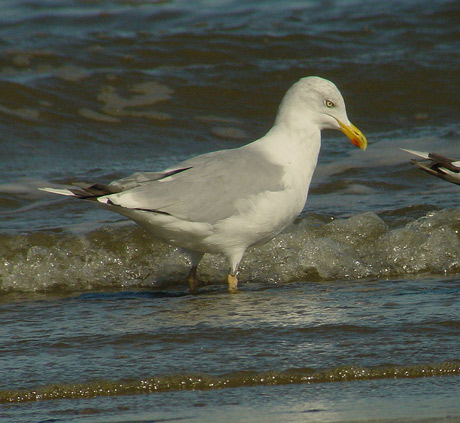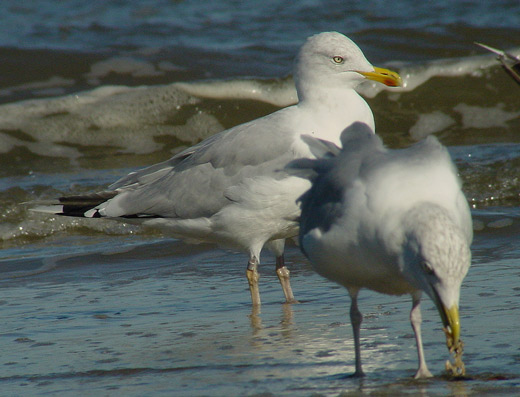 Herring
Gull - Zilvermeeuw (argentatus & argenteus)
Herring
Gull - Zilvermeeuw (argentatus & argenteus)
(last update: 31 januari 2005)
Home
Links
to Gull Sites
Gull Taxa
Gull Topography
Grey & Colour Charts
Locations in NW Europe
Summaries of Articles
About ORG
@
(3 images) Herring Gull 5.157.xxxadult (argenteus), September 24 2002, Scheveningen, the Netherlands.

A bird with yellowish legs, ringed Arnhem 5.157.???. The white tip on the outer primary p10 merges with the white mirror, without a visible sub-terminal mark. The adjacent black area reaches the inner-web over a distance as large as the white tip. Primary moult is still in progress with P6 slightly longer than P5. The legs are yellowish, especially when viewed from behind. In a frontal view the legs appear more pinkish.
From June (often mid-May in France, Belgium and the Netherlands) to October, a complete moult will bring birds in so-called "adult winter" plumage. A new set of primaries will grow during the summer months and by September, the outermost primaries P9-P10 are still present in argenteus in the Netherlands and northern France. In most adults, the new primary P6 is just visible beneath the tertials and shows a clear sub-terminal band. At the same time, the median coverts, outer lower lesser and outer greater coverts have been renewed and strongly contrast with the old, abraded adjacent wing-coverts. In summer, the head is still largely white, but by September, most adults develop extensive 'winter streaking', in sub-adults strongly mottled brown contrasting with the white breast as in an executioner's hood. The scapular coverts are plain grey, lacking white crescents. The tertials show obvious white tips. The iris is yellow. The bill is yellow with a red gonydeal spot confined to the lower mandible. The orbital ring is yellow-orange or orange-red in argenteus. The legs are flesh-pink in Dutch argenteus, although the odd individual shows slightly yellowish legs, as is illustrated by this bird.

